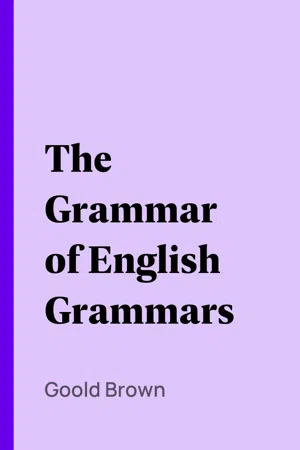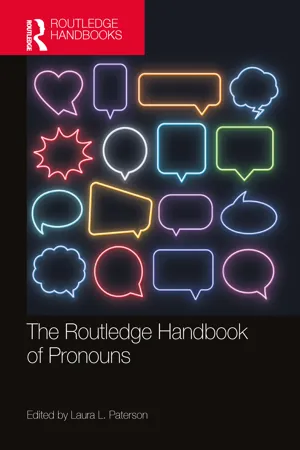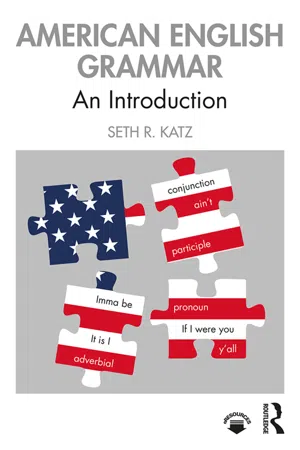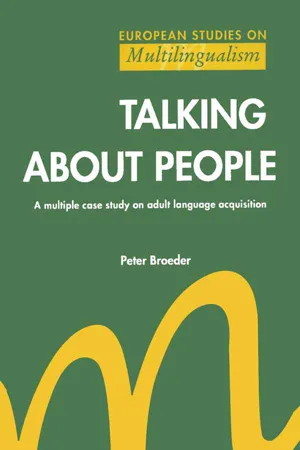Languages & Linguistics
Pronoun
A pronoun is a word that can function as a substitute for a noun or noun phrase. It is used to avoid repetition and make sentences less cumbersome. Pronouns can refer to people, places, things, ideas, or entire sentences, and they play a crucial role in language by allowing for more efficient and varied expression.
Written by Perlego with AI-assistance
Related key terms
Related key terms
1 of 4
Related key terms
1 of 3
7 Key excerpts on "Pronoun"
- eBook - ePub
- Collins Dictionaries(Author)
- 2016(Publication Date)
- Collins(Publisher)
Pronouns What is a Pronoun? A Pronoun is a word you use instead of a noun, when you do not need or want to name someone or something directly, for example, it , you , none . ➤ There are several different types of Pronoun: ● Personal Pronouns such as I, you, he, her and they, which are used to refer to you, the person you are talking to, or other people and things. They can be either subject Pronouns ( I, you, he and so on) or object Pronouns ( him, her, them, and so on). ● Possessive Pronouns like mine and yours, which show who someone or something belongs to. ● Indefinite Pronouns like someone or nothing, which refer to people or things in a general way without saying exactly who or what they are. ● Relative Pronouns like who , which or that, which link two parts of a sentence together. ● Interrogative Pronouns like who , what or which, which are used in questions. ● Demonstrative Pronouns like this or those, which point things or people out. ● Reflexive Pronouns, a type of object Pronoun that forms part of Spanish reflexive verbs like lavarse (meaning to wash ) or llamarse (meaning to be called ). ➪ For more information on Reflexive verbs , see page 91. ➤ Pronouns often stand in for a noun to save repeating it. I finished my homework and gave it to my teacher. Do you remember Jack? I saw him at the weekend. ➤ Word order with personal Pronouns is usually different in Spanish and English.Passage contains an image
42 Pronouns Personal Pronouns: subject What is a subject Pronoun? A subject Pronoun is a word such as I, he, she and they , that carries out the action expressed by the verb. Pronouns stand in for nouns when it is clear who or what is being talked about, for example, My brother isn’t here at the moment. He’ll be back in an hour. - eBook - ePub
- Goold Brown(Author)
- 2004(Publication Date)
- Perlego(Publisher)
CHAPTER V.—PronounS.
A Pronoun is a word used in stead of a noun: as, The boy loves his book; he has long lessons, and he learns them well.The Pronouns in our language are twenty-four; and their variations are thirty-two: so that the number of words of this class, is fifty-six.OBSERVATIONS.
OBS. 1.—The word for which a Pronoun stands, is called its antecedent, because it usually precedes the Pronoun. But some have limited the term antecedent to the word represented by a relative Pronoun. There can be no propriety in this, unless we will have every Pronoun to be a relative, when it stands for a noun which precedes it; and, if so, it should be called something else, when the noun is to be found elsewhere. In the example above, his and he represent boy, and them represents lessons; and these nouns are as truly the antecedents to the Pronouns, as any can be. Yet his, he, and them, in our most approved grammars, are not called relative Pronouns, but personal.OBS. 2.—Every Pronoun may be explained as standing for the name of something, for the thing itself unnamed, or for a former Pronoun; and, with the noun, Pronoun, or thing, for which it stands, every Pronoun must agree in person, number, and gender. The exceptions to this, whether apparent or real, are very few; and, as their occurrence is unfrequent, there will be little occasion to notice them till we come to syntax. But if the student will observe the use and import of Pronouns, he may easily see, that some of them are put substantively, for nouns not previously introduced; some, relatively, for nouns or Pronouns going before; some, adjectively, for nouns that must follow them in any explanation which can be made of the sense. These three modes of substitution, are very different, each from the others. Yet they do not serve for an accurate division of the Pronouns; because it often happens, that a substitute which commonly represents the noun in one of these ways, will sometimes represent it in an other.OBS. 3.—The Pronouns I and thou - eBook - ePub
- Laura L. Paterson, Laura L. Paterson, Laura L. Paterson(Authors)
- 2023(Publication Date)
- Routledge(Publisher)
PART 1 History and change
Passage contains an image
2 Variation in Pronoun typologies
Heather Bliss, Richard Compton, and Dennis Ryan StoroshenkoDOI: 10.4324/9781003349891-31. Introduction
Like other functional categories, Pronouns exhibit considerable cross-linguistic variation. They vary not only in their syntactic distribution and usage, but also in the featural contrasts they exhibit. Pronoun systems vary further in how they realize case and in the phonological status of pronominals, as clitics or independent words. Though less apparent than differences in outward form, Pronouns also vary in how their meanings are determined. A Pronoun is commonly understood as ‘replacing a noun’, but there are multiple mechanisms at work in grammar that allow speakers to fix on an interpretation of a given use of a Pronoun; that is, working out what exactly is being replaced. Across languages, Pronoun systems can vary in terms of the range of interpretation mechanisms available for a given form.Greenberg (1963) proposes a number of universals for pronominals, involving relative syntactic position, person, number, and gender contrasts:- Greenberg’s (1963 : 91–96) proposed universals regarding Pronoun typology:
- a. Universal 42: All languages have pronominal categories involving at least three persons and two numbers.
- b. Universal 43: If a language has gender categories in the noun, it has gender categories in the Pronoun.
- c. Universal 44: If a language has gender distinctions in the first person, it always has gender distinctions in the second or third person, or in both.
- d. Universal 45: If there are any gender distinctions in the plural of the Pronoun, there are some gender distinctions in the singular also.
More recent work encompassing larger sets of typologically diverse languages has recast Greenberg’s observations as strong implicational tendencies instead of absolutes. For instance, Harbour (2016b ) shows that Universal 42 does not hold for independent Pronouns, as there are languages that collapse either first and second person Pronouns or second and third person Pronouns, or which do not distinguish number on Pronouns. Similarly, Berg (2020) presents counter-examples to Universal 43 – languages with nominal gender categories but without those categories in Pronouns. Siewierska (2013) - eBook - ePub
American English Grammar
An Introduction
- Seth R. Katz(Author)
- 2019(Publication Date)
- Routledge(Publisher)
Pronouns (PRON) and Pronoun Phrases (PRONP)Pronouns are a category of function words. In traditional grammar, a PRO N is often defined as a word that stands in for or replaces a noun. In fact, a PRO N stands in the place of an entire NP or other nominal (see 11.1). We have already seen this concept in the Pronoun replacement test for identifying complete NPs. Consider the following sentences:- Franz bought the ball with the green spots.
- Franz bought it .
- *Franz bought the it with the green spots .
In the second sentence, the PRO N it replaces the entire NP the ball with the green spots . In the third sentence, when we try to replace only the noun—the head of the NP—with the Pronoun, we get nonsense. Remember that an NP consists of a noun and all its dependents, including DPs and modifiers (both ADJ Ps and adjectival post-modifiers, such as PP s).A PRO N is traditionally understood as referring back to an NP that appeared earlier in the discourse. The earlier NP is called the antecedent of the Pronoun. Sometimes, a PRO N precedes the NP to which it refers, in which case the NP is a post cedent, rather than an ante cedent.PRON and antecedent : The wizard startled everyone when he suddenly appeared in a puff of smoke.PRON and postcedent : When he suddenly appeared in a puff of smoke, the wizard startled everyone.Although Pronouns usually refer to NPs or other nominals, a PRO N may also refer to an entire sentence: So I dropped the objectivity and told them that I was shot when I was around their age . That got their attention! 1 In this example the PRO N that refers not just to the preceding NP their age or I but the entire action described in the clause I told them& age . Arguably, in this context, that might be labeled as a “pro-clause,” rather than a Pronoun, since its antecedent is an entire independent clause (a.k.a. a sentence) rather than an NP. However, in the second sentence of the example, That got their attention , the word that functions as the subject, a role that is always filled by a nominal. It is also reasonable to label that - eBook - ePub
- Peter Broeder(Author)
- 2013(Publication Date)
- Taylor & Francis(Publisher)
The deixis-anaphora distinction was rediscovered by the Indo-European scholars in the second half of the 19th century and the beginning of the 20th century, and influenced in particular Bühler's work (1934). In his Organon Model of Communication Bühler introduced what he calls a “pointing” field within which the referents of a linguistic sign may be located. The pointing field is made up of physical/imagined objects or states of affairs. The linguistic sign can be divided into pointing words and denoting words. Denoting words (such as nouns) have a constant, situation independent relationship to the referent. In contrast, pointing words select their referents relative to the situation from the pointing field. The class of pointing words can be used for two ways of pointing: “objectual” pointing which concerns reference to objects or states of affairs in the external world, e.g. This I would like to offer you, and “syntactic” pointing which concerns elements of the linguistic context, e.g. This worries me: the deterioration of the ozone layer. Bosch (1983: 11) remarks that Bühler is wrong in claiming that the two ways of pointing are similar to the classical deixis-anaphora distinction. In fact, Apollonius distinguished reference to given vs. new information within the linguistic discourse, whereas Bühler dealt with reference within the linguistic discourse vs. reference to the external world.Pronouns as substitutes
Within Bloomfieldian structuralism (1935), Pronouns are conceived as substitutes: forms which replace other elements in the linguistic discourse (in line with the classical account of Dionysius). A Pronoun is defined by its domain of substitution (i.e. the class of linguistic forms which a Pronoun can replace), and its substitution type (i.e. the semantic meaning of the domain of substitution). Thus the Pronoun I is defined as follows: “the substitute I replaces any singular substantive expression, provided that this substantive expression denotes the speaker of the utterance in which the substitute is used” (Bloomfield 1935: 247). Within structuralism, the focus was on the anaphoric function of Pronouns, i.e. on syntagmatic substitution. The same focus is found in a second influential linguistic school in the 20th century: generative grammar.Constraints on pronominal reference
Chomsky (1957) introduced the concept of generative grammar. In early theories of generative grammar, called TGG, the structuralist account of Pronouns as substitutes is stated in a transformation rule of pronominalization: a full-NP in deep structure is converted into a Pronoun in surface structure. The transformation rule is directed towards anaphoric relations with an explicit linguistic antecedent located within the same sentence as the Pronoun (e.g. Lees & Klima 1963). In recent theories of generative grammar, in the Government/Binding model (GB), the idea of transformations is abandoned (Chomsky 1981). Instead, the focus is on constraints on pronominalization. A number of binding principles restrict the possibilities of co-reference between an antecedent and a Pronoun. A distinction is made between anaphors, pronominals and referring expressions (r-expressions). The latter refer to something in the world, outside the sentence, e.g. John hurts. In contrast, anaphors always have their antecedent within the same sentence, or in GB-formulation: anaphors must be bound within their governing category, e.g. John hurts himself. Finally, pronominals do not have the antecedent within the same sentence: they must be free outside their governing category, e.g. John hurts him. Generative grammar theories deal with structural properties of Pronouns. - Anand Syea(Author)
- 2023(Publication Date)
- Routledge(Publisher)
4 PronounsDOI: 10.4324/9781003458289-44.1 Introduction
This chapter discusses different types of Pronouns in English creoles. Section 4.2 provides a brief overview of Pronouns in English. Section 4.3 then focuses on different types of Pronouns in English creoles. Section 4.3.1 looks at personal Pronouns, Section 4.3.2 at demonstrative Pronouns, Section 4.3.3 at possessive Pronouns, Section 4.3.4 at reflexive Pronouns, Section 4.3.5 at indefinite Pronouns, and Section 4.3.6 at interrogative and relative Pronouns. Section 4.4 provides a brief summary and a few concluding remarks.4.2 Pronouns in English
The traditional definition of a Pronoun is that it is a word that stands in the place of a noun. In an example like Mary saw Bill and she saw him, the Pronoun she replaces Mary and the Pronoun him replaces Bill. Pronouns, however, stand not only in the place of nouns but also in the place of noun phrases. Thus, in an example like The girl met the boy and she met him, the Pronoun she replaces not girl but the girl and the Pronoun him replaces not boy but the boy.Pronouns are of different types. These include personal, possessive, demonstrative, reflexive, indefinite, relative, and interrogative Pronouns.Personal Pronouns refer to first, second, and third person Pronouns like I, you, he, she, it, we, they. The Pronoun you can be both singular and plural. The Pronouns I, he, she, and it are singular while we and they are plural. Personal Pronouns in English, unlike nouns (genitive such as Mary’s excepted), display different morphological (case) forms: I, he, she, we, you, they are nominative whereas me, him, her, us, you, them are accusative/oblique and my, his, her, its, our, your, and their are possessive. Personal Pronouns display their nominative form when they are the subject of finite clauses e.g., We went for a long walk, their accusative form when they are the object of verbs e.g., Bill met us at the station or the subject of non-finite clauses e.g. Bill expected him to stay in Paris, their oblique form when they are the object of preposition e.g., Bill waved at us, and their possessive/genitive form when they occur as a determiner e.g., Bill met our friends. Beside encoding person, number (singular and plural) and case information, personal Pronouns also encode gender, but this is biological gender, and it is restricted to the third person singular he (masculine) and she- eBook - ePub
Grammar, Meaning, and Concepts
A Discourse-Based Approach to English Grammar
- Susan Strauss, Parastou Feiz, Xuehua Xiang(Authors)
- 2018(Publication Date)
- Routledge(Publisher)
5 Alternate Ways to Identify, Specify, Underspecify, Focus On, and Quantify Things, People, and Ideas in DiscoursePronouns
Figure 5.1 “IPOD/YOUPOD/WEPOD/THEYPOD”© Randy Glasbergen. Reproduced with permission of Glasbergen Cartoon Service.The focus in Chapter 3 is the noun and Chapter 4 , the determiner. Nouns and noun phrases (NPs) are central, if not the central element, in all of human communication.This chapter covers Pronouns—words like we, us, ourselves, they, she, it, I, herself, me, anyone, someone, this, that, and nothing. These are words that replace a noun or other noun-like structures (like noun phrases and noun clauses) as referents in discourse. The noun or noun-like structure replaced by a Pronoun is called the antecedent.Like determiners, Pronouns evoke conceptual meanings—meanings that relate to specificity, identifiability, focus, number, ownership, possession (and possession-like qualities, e.g., preference, affiliation; see Chapter 4 ). In fact, some of the same forms used for demonstrative, quantifier, and interrogative determiners also function as Pronouns in discourse. Pronouns add other powerful features of conceptual meaning in discourse, as we will see in this chapter.The opening cartoon is a play on words, based on the mini electronic audio/tablet device known as an iPod. The humor derives from the apparent possible (but really impossible) separation of the initial i from the second element pod, thus yielding a simple and traditional-looking substitution drill switching from I as a subject Pronoun to you, and then to we and finally to they
Index pages curate the most relevant extracts from our library of academic textbooks. They’ve been created using an in-house natural language model (NLM), each adding context and meaning to key research topics.
Explore more topic indexes
Explore more topic indexes
1 of 6
Explore more topic indexes
1 of 4






